
The Benefits of Ginger—and How to Use This Spicy, Flavorful Root
Fewer ingredients are more iconic than ginger. It’s known for its spicy and pungent flavor and impressive health benefits. Its intense bite might be an acquired taste, but its effects on the body might convince you to use ginger more often. It adds zest and warmth to a variety of dishes, from savory to sweet and from soups to cakes. It can also be used in simpler preparations, such as ginger tea or as a garnish. Learn about ginger’s impressive powers, plus ideas for using it at home, according to experts.
Ginger 101
Ginger is a spice that comes from Zingiber officinale, a flowering plant native to Southeast
Asia. The edible part is the rhizome, or the part of the stem that grows underground. For this reason, ginger is sometimes called “ginger root.”
Nutrition and Health Benefits
Ginger has been used as an herbal supplement and culinary ingredient for thousands of years, and it’s no wonder. The spice boasts numerous health benefits for the body, which are outlined below.
Reduces Disease Risk
Ginger is rich in anti-inflammatory and antioxidant compounds, including gingerols and shogaols. These compounds fight inflammation and oxidative stress, respectively, making them important for good health. The reason? Over time, inflammation and oxidative stress can damage healthy cells and tissues. This can “put you at a higher risk for developing chronic diseases, such as diabetes, cardiovascular disease, and cancer,” says Stacey Pence, MPH, RDN, LD, ACSM-EP, registered dietitian nutritionist at The Ohio State University Wexner Medical Center.
Relieves Nausea
The next time you’re feeling nauseous, reach for ginger. It’s been shown to ease nausea by interacting with certain neurotransmitters (i.e., chemical messengers) that affect the digestive tract. So much so that studies support the use of ginger for reducing the severity of nausea and vomiting during pregnancy, says Pence. It’s also helpful for alleviating nausea due to motion sickness and chemotherapy, according to research.
Eases Pain
Inflammation is at the root of pain, but thanks to the anti-inflammatory properties of ginger, the ingredient might also alleviate pain. Thus, it’s been traditionally used to relieve pain caused by menstrual cramps, joint discomfort, back issues, and migraines, among many others. It’s all thanks to the gingerols in ginger, which reduce inflammation by suppressing specific cellular reactions.
May Control Blood Sugar
Ginger may have some benefits for blood sugar control in people with type 2 diabetes and gestational diabetes, according to Pence. It’s thought to work by increasing insulin, the hormone that regulates blood sugar.
Side Effects of Ginger
Although ginger offers many health benefits, it shouldn’t be eaten in large amounts. Overconsuming ginger “may cause gastrointestinal issues such as belching, heartburn, diarrhea, abdominal discomfort, and bloating,” shares Pence.
Buying Ginger
At the grocery store, ginger is available in many forms—including fresh, dried, powdered, pickled, and crystallized. When choosing fresh ginger, look for pieces that are firm with thin, taut, and shiny light brown or beige skin, says Michael Handal, chef-instructor at the Institute of Culinary Education. Avoid ginger with wrinkled skin and blemishes, cuts, or mold.
How to Eat Ginger
Sidney Bensimon
As a spice, ginger is often used in small amounts in recipes—i.e, you likely won’t eat it like a vegetable. But due to its intense flavor and odor, a little will go a long way. In fact, ginger can quickly overpower other ingredients, so you’ll want to use a light hand.
Raw ginger gets its pungent taste from gingerol, the same compound responsible for its many health benefits. This flavor is often described as citrusy, woody, spicy, and peppery, according to Handal. When cooked, gingerol turns into zingerone, “which softens the bite of fresh ginger, allowing it to become sweeter and warmer with less pungency,” says Handal.
Complementary Ingredients
Ginger is an ideal partner for a variety of ingredients. It’s delicious with a range of fruits and vegetables, including onions, shallots, pumpkin, eggplant, apples, peaches, and citrus fruits, per Handal. Ginger also pairs well with other spices—such as cloves, cinnamon, and vanilla—as well as herbs, including parsley and mint. Additionally, the spiciness of ginger can balance sweeter ingredients, such as chocolate, maple syrup, brown sugar, and honey, says Handal.
Candied
Candied ginger, or ginger glacè, can be enjoyed as a sweet treat or an anti-nausea remedy, per Handal. “It may also be diced and added to other items, such as ice cream and baked goods,” he says.
Soups
Ginger can add another level of warmth to a comforting soup. Use it to elevate a basic chicken soup or puree it in a Creamy Carrot, Tomato, and Ginger Soup.
Cooked Vegetables
Give your go-to vegetable side dishes a lift with ginger. Use it as garnish for boiled carrots with honey or fresh cucumbers with spicy chili oil.
Condiments
Ginger adds brightness and zest to myriad condiments, from ginger-lime dressing to gingery tomato-basil sauce. For best results, Handal recommends grating ginger with a microplane zester (rather than micing), as this will yield a pureed texture that’s perfect for seamlessly incorporating into liquids.
Baked Goods
When used in baked goods, ginger provides a warm depth of flavor that complements sweet ingredients. It’s especially divine with citrus, as seen in our recipes for Lemon-Ginger Bundt Cake and Big Almond-Orange-Ginger Cookie. Craving a more classic treat? Try making chewy ginger cookies or Ginger Pumpkin Bread.
Beverages
For a rejuvenating drink without caffeine, brew a cup of ginger tea or Hot Apple Cider With Ginger. The ingredient also works well in cold drinks, as seen in our recipes for Hibiscus-Ginger Spritz and Grapefruit, Carrot, and Ginger Juice. In smoothies, it’s best with sweet ingredients like pineapple or berries, which will cut through the pungency.
Proteins
Ginger, like garlic, is a popular aromatic for for all kinds of protein dishes. Use it add flavor to chicken, shrimp, and pork, just to name a few options.









